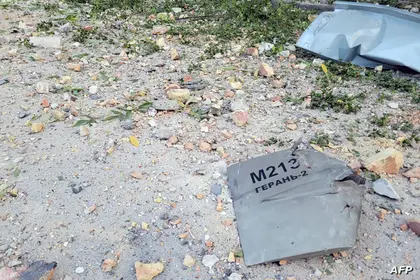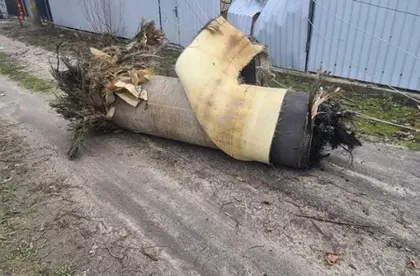Russia’s acclaimed 3M22 Tsirkon hypersonic missile was fired in anger for the first time as part of a 40-plus-strong missile attack on Ukraine on Wednesday, Feb 7. The missile was shot down over Kyiv by Ukrainian air defenses on that occasion and analysis of its flight profile and examination of the missile remnants cast doubt over Russia’s claims of its performance and capability as a hypervelocity weapon - the accepted definition of which means one that flies more than five times the speed of sound (Mach 5).
The same conclusions could be drawn over the second use of the missiles that hit Kyiv on Monday, March 25, one of which was shot down by a Ukrainian air defense asset, probably an MIM-104 Patriot surface-to-air missile (SAM). Technical examination of this missile cast further doubt on it being a true hypersonic weapon and its destructive capability.
JOIN US ON TELEGRAM
Follow our coverage of the war on the @Kyivpost_official.
History
Development of the Tsirkon hypersonic missile began in 2011. It was originally designed as an anti-ship missile for the Russian Navy to be fired from designated frigates and submarines using modified ZS-14 launch platforms.
Test firings of the Tsirkon prototypes in 2020 and 2021 suggested the weapon was highly accurate achieving direct hits on naval targets with an assessed CEP (circular error probability) of around 3-5 meters, i.e. it will land within 3-5 meters of the intended target, which with a 400-kilogram warhead is near enough.

Russia’s Overnight Drone Strike Damages Residential Houses in Kyiv, Cherkasy Regions
In 2020 a missile launched from the frigate the Admiral Gorshkov hit a coastal target at 500 kilometers. In 2021 a missile fired sub-surface from the Severodvinsk nuclear-powered submarine hit its seaborne target, the distance wasn’t specified. In 2022, Russia announced the creation of an unidentified ground-based launcher for the hypersonic missile before the weapon was supposedly formally brought into service in 2023.
Some sources claim it is still not fully in service, an assessment which is supported somewhat by the markings on the wreckage of the missile brought down in February where many markings on components appeared to be handwritten.
The missiles are produced by the Russian missile manufacturer NPO Mashinostroyeniya. This is the same company that makes the Oniks anti-ship missile which Russia has also been using as a ground attack weapon against Ukraine.
Hypersonic or not?
According to the conventional literature, the 3M22 Tsirkon missile is a scramjet-powered, nuclear-capable, hypersonic, maneuverable, cruise missile.
Tsirkon is a three-stage missile. A rocket motor lifts it out of its launcher before a solid fuel booster motor ignites and accelerates it to supersonic speed and its operating altitude of 30-40 kilometers. At this point, the booster motor separates, and the liquid-fueled scramjet motor takes over to bring it to its cruising speed of Mach 5.5 (the lower limit of hypervelocity) for the bulk of its declared 1,000-kilometer plus range.
It is during its final descent on its target that Tsirkon accelerates, under the combined force of its jet engine and gravity, to Mach 7.5 – 8 (9,000-10,000 kph/ 6,000 mph), which as it approaches final impact slows again to supersonic speed (around Mach 4.5) once its fuel is expended and air resistance increases.
In theory, the flight time to Kyiv from the launch site on the Crimean Peninsula, which is around 650 kilometers, should have taken 4-5 minutes if the missiles were flying at the advertised speeds. That’s what the book solution says. The Feb. 7 and March 25 missiles while very fast at no time reached anything close to sustained hypervelocity.
Even so, the speeds achieved were sufficient to reduce the warning time of the attack from launch to impact. That was partly down to the speed achieved and the fact that the March 25 missiles were fired from a land-based platform, making it harder to detect launch. They were likely fired from the K-300 Bastion coastal defense system which had earlier been adapted to fire Oniks anti-ship missiles and was the main suspect for the Feb. 7 Tsirkon firing.
Social media reports suggest that up to five Bastions have now been modified to fire both Oniks and Tsirkon.
Destructive power
There is once again a disconnect between the declared size and destructive power of the missile warhead. It was supposed to carry a warhead with a total weight of 400 kilograms as either a high explosive fragmentation or a 2-kiloton thermonuclear payload.
Technical examination of the missile shot down on March 25 by the KNIISE military research laboratory was found to have a warhead containing only around 40 kilograms of high explosives, big enough to do damage to a building but nowhere near the devastating power it was assumed to present.
Accuracy
Tsirkon is an expensive weapon with an estimated cost of around $10 million each. If that is the case then one would expect it to be fired at targets of high strategic, operational, or financial value. The Feb. 7 missile only hit and cut a domestic powerline while the one that got through on March 25 struck a semi-derelict, uninhabited three-story building.
Of the three Tsirkons encountered thus far, none were even close to what could be considered a worthwhile military target.
Some assessments indicate that Russian forces positioned to oppose Ukraine may hold 20 or fewer of the missiles which many still consider to be in the prototype stage.
Vulnerability
It has long been a Russian boast that its newest weapons, such as the 3M22 Tsirkon and the Kh-47M2 Kinzhal hypersonic missiles, can defeat all existing missile defense systems. Both weapons have been used in attacks on Ukraine and, while they undoubtedly are more difficult to counteract than Shahed / Geran UAVs or slower-moving cruise missiles, the US Patriot and Franco-Italian SAMP-T systems have been successful in bringing them down whenever they have been encountered.
Sadly, Ukraine has insufficient numbers of these and other air defense systems to protect every city or key infrastructure facility. Even when a missile enters the protective envelope of these defense assets the speed of approach means that often they are struck down close to their intended target or over inhabited areas so that falling debris remains a threat.
Fate of Russia’s Hypervelocity scientists
It was announced on Tuesday that a 12th scientist, Dr Alexander Kuranov, who was involved in hypervelocity research and development of Russia’s hypersonic missiles had been arrested and charged with treason.
Some believe that this is because, as has been common practice for decades, scientists from all over share information, make presentations at international seminars, and publish technical papers, which President Putin has interpreted as giving away state secrets.
Others think the reason may be more prosaic. Despite investing millions if not billions in their development and over-optimistic assessments of performance and capability – the missiles simply don’t work anywhere near the levels they are supposed to.
Certainly, while these missiles remain a threat to the people of Ukraine, they are nowhere near being the game-changing weapon that Putin boasted about in his infamous 2018 presidential address to Russia’s Federal Assembly in Moscow.
You can also highlight the text and press Ctrl + Enter






